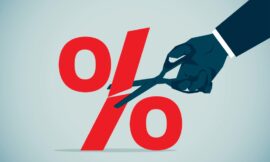If, or When, Will the BoC Start To Cut The Rates?

The Bank of Canada (BoC) isn’t expected to cut its policy rate, so the focus this time will be for hints on the timing of when the first one will occur.
Bond-market investors expect the BoC to start cutting in April, although the actual timing will depend on what happens with inflation, which is still well above the Bank’s 2% target and ticked higher, to 3.4%, in December.
BoC Governor Macklem has confirmed that the Bank won’t wait until inflation falls all the way back to 2% before starting to cut. He recently explained that the Bank will begin to ease once it believes that inflation is “on a sustained downward track” back to 2%.
So, what will that sustained downward track look like?
The BoC has said that to gauge our progress toward price stability, it is focused on four key areas: excess demand, inflation expectations, wage growth, and corporate pricing.
Here is an update on the status of each of these components:
– In his final speech of 2023, Governor Macklem observed that “the excess demand that drove prices higher over the past two years is now gone”. That assessment was backed up by the latest retail sales data, for November, which Statistics Canada released last Friday. It showed a decline of 0.2% during the month, bolstering Governor Macklem’s claim in the same speech that “higher interest rates and tighter global financial conditions have helped the economy rebalance”.
– Last week we also received the latest business and consumer surveys.
The Business Outlook Survey (BOS) results for Q4, 2023 confirmed that “short-term inflation expectations are trending downward”, although “about one-quarter of firms … believe inflation will not return to the Bank’s 2% target in the next four years”. That said, “only a few [businesses] are changing their behaviour in line with their outlook”.
The Canadian Survey of Consumer Expectations for Q4 2023 showed that “people perceive inflation to be lower”. Despite that, “expectations for near-term inflation have not changed much” whereas “expectations for inflation in the long term have fallen further below the historical average”. Households also reported an increase in financial stress. About one-third of those surveyed believe that “higher rates are just beginning to affect their spending”.
– Average hourly wages rose by 5.4% in December, up from 4.8% in November, but leading indicators portend a slowdown in wage gains ahead. For example, we created only 100 new jobs in December, job vacancies are declining, and increased layoffs may not be far off.
The latest BOS survey confirmed that “most firms do not feel the need to add staff and are experiencing less intensive labour shortages”. Furthermore, “an increasing share of firms are planning to make modest reductions in staffing … [and are also] finding it easier to recruit qualified candidates”. The BOS results confirmed that, on an overall basis, “wage growth continues to trend downward”.
The latest Survey of Consumer Expectations also confirmed that “fewer consumers are pushing for higher pay or looking for more income in response to their inflation expectations”.
– The latest BOS Survey confirmed that “pricing behaviour is slowly returning to normal” and that “fewer firms plan unusually large price increases”.
In summary, excess demand is no longer a concern, expectations of higher inflation are proving sticky, wage growth is still high but should start to moderate soon, and corporate pricing is in the process of normalizing.
That all adds up to progress but with room for improvement.
The next question is how long it will take for more progress to accrue. My answer: not that long.
Only about half of Canadian mortgage borrowers have renewed at higher rates thus far, and Stats Can recently confirmed that mortgage costs already now account for the highest portion of disposable income on record. Spending should be under more pressure as higher borrowing costs increase their bite, and that will feed into corporate pricing behaviour and inflation expectations.
It will be interesting to see whether the BoC will directly address the particularly narrow nature of today’s inflation pressure (given that inflation, excluding shelter, is now running at 2.1%).
The dramatic drop in Government of Canada (GoC) bond yields to start this year ran at cross-purposes with the Bank’s attempts to maintain tight monetary policy. I expect that its messaging will try to limit any further decline in our bond yields over the near term.
The Bottom Line: GoC bond yields moved sharply higher last week. If that trend continues for much longer, borrowers should expect our fixed mortgage rates to start rising.
Variable mortgage rate discounts were unchanged last week.
It would be a shock if the BoC raises its policy rate this week. Variable-rate borrowers shouldn’t have to worry about higher rates, but they should be prepared for the Bank to push back against expectations that its first cut will arrive in April.

.jpg?width=883&height=328&name=Rate%20Table%20(Janaury%2022%2c%202024).jpg)





